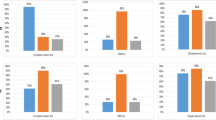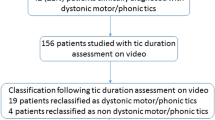Abstract
Background
Tics are the hallmark of Tourette syndrome (TS). However, TS patients may have a particular vulnerability to develop other movement disorders (MDs), such as dystonia, chorea, stereotypy, and other hyperkinetic disorders that may be wrongly attributed to tics.
Materials and methods
We studied a cohort of 201 patients with motor and phonic tics associated with TS to determine if they have additional, co-existent, MDs.
Results
There were 67 (33.3%) patients with comorbid non-tic MDs. Phenomenology-wise, piano-playing movements resembling chorea or myoclonus, were the most common non-tic movement, observed in 11% of cases, followed by stereotypies (8.0%), tremor, dystonia and parkinsonism, 5.0% each. Drug-induced was the most common etiology (6.0%), followed by functional movement disorders (5.0%) and tardive phenomena (5.0%). No clear etiology was identified in most patients. Piano-playing movements, were associated with a younger age at onset (P = 0.004) and younger age at presentation (P < 0.001). Patients with drug-induced movements and tardive phenomena had a lower frequency of craniofacial tics. FMDs, and idiopathic MDS showed no specific associations with TS. Tic severity was not a predictor of any co-existent MD.
Conclusion
About a third of patients with TS present with comorbid MDs which should be differentiated and distinguished from tics as their etiopathogenesis and treatment may be different.
Similar content being viewed by others
References
American Psychiatric Association (2013) Diagnostic and statistical manual of mental disorders, 5th edn. Author, Arlington
Avanzini G, Shibasaki H, Rubboli G, Canafoglia L, Panzica F, Franceschetti S, Hallett M (2016) Neurophysiology of myoclonus and progressive myoclonus epilepsies. Epileptic Disord 18:11–27
Baizabal-Carvallo JF, Cardoso F (2020) Chorea in children: etiology, diagnostic approach and management. J Neural Transm (vienna) 127:1323–1342
Baizabal-Carvallo JF, Jankovic J (2014) The clinical features of psychogenic movement disorders resembling tics. J Neurol Neurosurg Psychiatry 85:573–575
Baizabal-Carvallo JF, Hallett M, Jankovic J (2019) Pathogenesis and pathophysiology of functional (psychogenic) movement disorders. Neurobiol Dis 127:32–44
Bharucha KJ, Sethi KD (1995) Tardive tourettism after exposure to neuroleptic therapy. Mov Disord 10:791–793
Blackburn J, Parnes M (2021) Tics, tremors and other movement disorders in childhood. Curr Probl Pediatr Adolesc Health Care 51:100983
Bonnet C, Roubertie A, Doummar D, Bahi-Buisson N, Cochen de Cock V, Roze E (2010) Developmental and benign movement disorders in childhood. Mov Disord 25:1317–1334
Bruun RD (1988) Subtle and underrecognized side effects of neuroleptic treatment in children with Tourette’s disorder. Am J Psychiatry 145:621–624
Carson A, Lehn A (2016) Epidemiology. Handb Clin Neurol 139:47–60
D’Agati E, Casarelli L, Pitzianti MB, Pasini A (2010) Overflow movements and white matter abnormalities in ADHD. Prog Neuropsychopharmacol Biol Psychiatry 34:441–445
Damásio J, Edwards MJ, Alonso-Canovas A, Schwingenschuh P, Kägi G, Bhatia KP (2011) The clinical syndrome of primary tic disorder associated with dystonia: a large clinical series and a review of the literature. Mov Disord 26:679–684
Fahn S, Williams DT (1998) Psychogenic dystonia. Adv Neurol 50:431–455
Frei K, Truong DD, Fahn S, Jankovic J, Hauser RA (2018) The nosology of tardive syndromes. J Neurol Sci 389:10–16
Ganos C, Mencacci N, Gardiner A, Erro R, Batla A, Houlden H, Bhatia KP (2014) Paroxysmal kinesigenic dyskinesia may be misdiagnosed in co-occurring gilles de la tourette syndrome. Mov Disord Clin Pract 1:84–86
Golden GS (1985) Tardive dyskinesia in Tourette syndrome. Pediatr Neurol 1:192–194
Jankovic J (2001) Tourette’s syndrome. N Engl J Med 345:1184–1192
Jankovic J (2016) Leg stereotypy disorder. J Neurol Neurosurg Psychiatry 87:220–221
Jankovic J, Kurlan R (2011) Tourette syndrome: evolving concepts. Mov Disord 26:1149–1156
Jankovic J, Roos RA (2014) Chorea associated with Huntington’s disease: to treat or not to treat? Mov Disord 29:1414–1418
Jankovic J, Hallett M, Okun M, Comella C, Fahn S (2021) Principles and practice of movement disorders. Elsevier, Philadelphia ((in press))
Kompoliti K, Goetz CG (1998) Hyperkinetic movement disorders misdiagnosed as tics in Gilles de la Tourette syndrome. Mov Disord 13:477–480
LaFaver K (2020) Treatment of functional movement disorders. Neurol Clin 38:469–480
Lees AJ, Robertson M, Trimble MR, Murray NM (1984) A clinical study of Gilles de la Tourette syndrome in the United Kingdom. J Neurol Neurosurg Psychiatry 47:1–8
Lotia M, York MK, Strutt AM, Jankovic J (2018) Leg stereotypy syndrome: phenomenology and prevalence. J Neurol Neurosurg Psychiatry 89:692–695
Macneil LK, Xavier P, Garvey MA, Gilbert DL, Ranta ME, Denckla MB, Mostofsky SH (2011) Quantifying excessive mirror overflow in children with attention-deficit/hyperactivity disorder. Neurology 76:622–628
McAuliffe D, Hirabayashi K, Adamek JH et al (2020) Increased mirror overflow movements in ADHD are associated with altered EEG alpha/beta band desynchronization. Eur J Neurosci 51:1815–1826
Mostofsky SH, Newschaffer CJ, Denckla MB (2003) Overflow movements predict impaired response inhibition in children with ADHD. Percept Mot Skills 97:1315–1331
Nutt JG, Muenter MD, Aronson A, Kurland LT, Melton LJ 3rd (1988) Epidemiology of focal and generalized dystonia in Rochester. Minnesota Mov Disord 3:188–194
Pringsheim T, Freeman R, Lang A (2007) Tourette syndrome and dystonia. J Neurol Neurosurg Psychiatry 78:544
Savitt D, Jankovic J (2018) Tardive syndromes. J Neurol Sci 389:35–42
Singer HS (2013) Motor control, habits, complex motor stereotypies, and Tourette syndrome. Ann N Y Acad Sci 1304:22–31
Singh SK, Jankovic J (1988) Tardive dystonia in patients with Tourette’s syndrome. Mov Disord 3:274–280
Stone LA, Jankovic J (1991) The coexistence of tics and dystonia. Arch Neurol 48:862–865
Tang X, Seymour KE, Crocetti D, Miller MI, Mostofsky SH, Rosch KS (2019) Response control correlates of anomalous basal ganglia morphology in boys, but not girls, with attention-deficit/hyperactivity disorder. Behav Brain Res 367:117–127
Tinazzi M, Geroin C, Erro R et al (2020) Functional motor disorders associated with other neurological diseases: Beyond the boundaries of “organic” neurology. Eur J Neurol. https://doi.org/10.1111/ene.14674
Ubhi M, Achinivu K, Seri S, Cavanna AE (2020) Motor stereotypies in adult patients with Tourette syndrome. Future Neurol 15:FNL42
Yaltho TC, Jankovic J, Lotze T (2011) The association of Tourette syndrome and dopa-responsive dystonia. Mov Disord 26:359–360
Acknowledgements
None.
Funding
None.
Author information
Authors and Affiliations
Contributions
Dr. Baizabal-Carvallo: Research project: conception, organization, execution; manuscript: writing of the first draft, review and critique. Dr. Jankovic: Research project: conception, organization, execution. Statistical analysis: design, execution, review and critique.
Corresponding author
Ethics declarations
Conflict of interest
None for all authors. Financial Disclosures for the previous 12 months: Royalties: Dr. Baizabal-Carvallo has received royalties from Medlink Neurology, Editorial Boards: Dr. Baizabal-Carvallo serves as Associated Editor in BMC Neurology. Dr. Jankovic: Research Support: Allergan, Inc; Allon Therapeutics; Biotie; Ceregene, Inc; Chelsea Therapeutics; Diana Helis Henry Medical Research Foundation; EMD Serono; Huntington’s Disease Society of America; Huntington Study Group; Impax Pharmaceuticals; Ipsen Limited; Lundbeck Inc; Medtronic; Merz Pharmaceuticals; Michael J Fox Foundation for Parkinson Research; National Institutes of Health; National Parkinson Foundation; Neurogen; St. Jude Medical; Teva Pharmaceutical Industries Ltd; University of Rochester; Parkinson Study Group. Consultant or Advisory Committee Member: Allergan, Inc; AstraZeneca, Chelsea Therapeutics; EMD Serono; Lundbeck Inc; Merz Pharmaceuticals; Michael J Fox Foundation for Parkinson Research; Neurocrine Biosciences, Inc; Teva Pharmaceutical Industries Ltd. Editorial Boards: Elsevier; Medlink: Neurology; Neurology in Clinical Practice; Neurotoxin Institute; Scientiae; UpToDate.
Ethical statement
We confirm that we have read the Journal’s position on issues involved in ethical publication and affirm that this work is consistent with those guidelines. The authors confirm that the approval of an institutional review board was not required for this work; however, all patients provided signed written informed consent for video recording and its publication approved by the Baylor College of Medicine Review Board.
Additional information
Publisher's Note
Springer Nature remains neutral with regard to jurisdictional claims in published maps and institutional affiliations.
Supplementary Information
Below is the link to the electronic supplementary material.
Video 1: This is an 11-year-old male with a 5-year history of motor, chiefly facial, tics, exhibiting jerky continuous piano-playing movements in both upper limbs (AVI 94332 kb)
Video 2: This is a 15-year-old male with an 8-year history of motor tics and piano-playing movements in both hands (AVI 77787 kb)
Video 3: This is an 8-year-old male with a 3-year history of oculogyric, neck and shoulder tics, who exhibits upper and lower limb repetitive movements consistent with stereotypies (AVI 59267 kb)
Video 4: This is a 24-year-old female with a childhood onset of tics and fixed dystonic flexion of fingers of the left hand and flexion of the left elbow (AVI 76676 kb)
Video 5: This is a 21-year old male patient with a 9-year history of complex motor tics who also manifests episodic dystonic postures in the left hand (AVI 96431 kb)
Rights and permissions
About this article
Cite this article
Baizabal-Carvallo, J.F., Jankovic, J. Beyond tics: movement disorders in patients with Tourette syndrome. J Neural Transm 128, 1177–1183 (2021). https://doi.org/10.1007/s00702-021-02386-0
Received:
Accepted:
Published:
Issue Date:
DOI: https://doi.org/10.1007/s00702-021-02386-0




